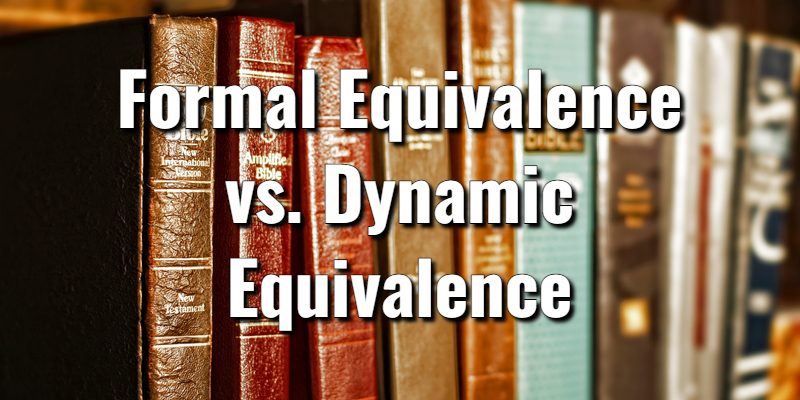Lord’s Library explores various Christian topics by comparing formal equivalence vs. dynamic equivalence to help you gain an understanding.
A look on the shelf of your favorite digital Christian bookstore quickly reveals a number of different Bible versions to choose from. What’s with all these translations, and why do so many exist? Isn’t a Bible just a Bible? There are many answers to this question, beginning with the most obvious like a growing number of Christian denominations, as well as the manuscripts that were used during translation.
To begin answering this question one must also understand the two overarching philosophies that dictate modern Bible translation. This resource compares formal equivalence vs. dynamic equivalence for this very reason. By better understanding these two Bible translation methods, one can see how the myriad of different Bible types came to be.
Formal Equivalence vs. Dynamic Equivalence
What is Formal Equivalence? Formal Equivalence Definition
Formal equivalence, also known as word-for-word translating, is a translation methodology that focuses on translating the Biblical text with as much accuracy as possible. To achieve this, translators strive to translate the best Hebrew, Greek, and Aramaic manuscripts available as close to word-for-word as possible. This is not 100 percent possible, as translating isn’t codebreaking. It’s important to remember that every translation is in some way an interpretation.
Differences in language, grammar, and syntax that exist between the different languages, as well as the very long stretch of time between the Biblical manuscripts and today, make a true 100 percent word-for-word translation nearly impossible.
The formal equivalence philosophy of translation seeks to change the original text as little as possible (minimizing human impact), while still relaying the correct meaning. They are willing to encourage the reader to do some research if necessary instead of changing the text to add context or meaning. A good Bible translation seeks to communicate the meaning of the Hebrew, Greek, or Aramaic in a way that is also readable in the modern receptor language.
What may be communicated with one word in the original language may take three words in the receptor language or vice versa. In addition to different grammatical structures, there will also be differences in the social, cultural, and historical contexts. Not all language is to be understood “literally” because people use similes, metaphors, and idioms that cannot be perfectly understood.
Formal Equivalence Defined
What is Dynamic Equivalence? Dynamic Equivalence Definition
Dynamic equivalence is a Bible translation method that strives to relay the original meaning of the Scriptures using modern language in an attempt to communicate the overall message. Using this method, a translator would seek to reproduce the overall meaning of a passage instead of trying to create a strict word-for-word rendering of it in English. In the dynamic equivalence translation process, the original context, culture, and idioms are considered alongside the text itself.
A pitfall of the dynamic equivalence method is that it leads to interpretive decisions that can sometimes miss the point of the original text and introduce foreign ideas. If the translators take too much liberty with the text, interpretive errors may prevent a faithful communication of God’s Word. Some subjectivity naturally exists within dynamic equivalence, allowing for widely varying versions of the same Bible verses.
Dynamic Equivalence Defined
Formal Equivalence vs. Dynamic Equivalence; What’s the Difference?

It’s important to note that many Bible versions will find a middle ground, blurring the lines between these two translation methods. An example would be the New International Version, which follows many of the guidelines of a word-for-word philosophy but also strives toward a higher level of readability by being flexible in the translation of difficult passages.
Literal translations make the original language more transparent but can sound awkward to the modern ear and therefore require clarification. Dynamic translations tend to be easier for modern readers to understand but may hide or lose some of the ancient elements of the text, such as cultural themes, wordplay, allusions, and figures of speech. While different in their approaches, both translation philosophies endeavor to be faithful to the original text.
Here is an example of formal equivalence vs. dynamic equivalence side-by-side, using Matthew 18:28:
Formal Equivalence (English Standard Version):
“But when that same servant went out, he found one of his fellow servants who owed him a hundred denarii, and seizing him, he began to choke him, saying, ‘Pay what you owe.”
A footnote explains that a denarius was a day’s wages for a laborer. This sum is compared to 10,000 talents that the servant owed the king, and a footnote explains that a talent was about 20 years’ wages.
Dynamic Equivalence (New Living Translation):
“But when the man left the king, he went to a fellow servant who owed him a few thousand dollars. He grabbed him by the throat and demanded instant payment.”
The thousand-dollar sum is compared to the “millions of dollars” the servant owed the king in verse 24.
Here is another example of formal equivalence vs. dynamic equivalence side-by-side, using Psalm 23:1:
Formal Equivalence (New American Standard Bible):
“The Lord is my shepherd, I shall not want.”
Dynamic Equivalence (New Living Translation):
“The Lord is my shepherd; I have everything I need.”
Lord's Library participates in affiliate programs. We may make a small commission from products purchased through this resource.
- What Does the Bible Say About Discernment? With Key Scriptures - July 19, 2024
- What Does the Bible Say About Disobedience? With Key Scriptures - July 19, 2024
- 1 Timothy 1:12 Meaning: Commentary on an Important Scripture - July 11, 2024












